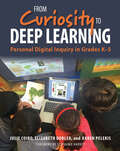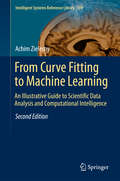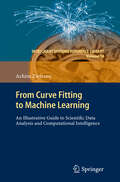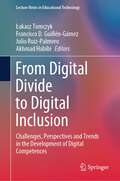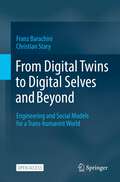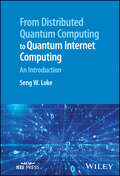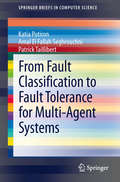- Table View
- List View
From CSCW to Web 2.0: Selected Papers from COOP08 (Computer Supported Cooperative Work)
by David Randall Pascal SalembierMany challenges were identified in CSCW some thirty years ago, and some of these remain problematic today. However they are being progressively transformed and this edited volume contains contributions that demonstrate how these new challenges are being dealt with in a variety of ways, reflecting the balance of rigour and creativity that has always characterised the field. Originally presented at COOP ’08 which took place in Carry-le-Rouet, France in 2008, the contributions to this volume have been substantially extended and revised. New technologies, new domains and new methods are described for supporting design and evaluation. Taking a progressive and critical stance, the authors cover a variety of themes including inter-organisational working, non task-based environments, creativity, and the development of Web 2.0 (and even Web 3.0) applications, including new cooperative mechanisms and new classification possibilities.
From Curiosity to Deep Learning: Personal Digital Inquiry in Grades K-5
by Julie Coiro Elizabeth Dobler Karen PelekisFrom Curiosity to Deep Learning: Personal Digital Inquiry in Grades K-5 reveals the powerful learning that results when you integrate purposeful technology into a classroom culture that values curiosity and deep learning. The centerpiece of this practical guide is Personal Digital Inquiry (PDI), a framework developed by Julie Coiro and implemented in classrooms by her co-authors, Elizabeth Dobler and Karen Pelekis. Clear, detailed examples offer ideas for K-5 teachers and school librarians to support their teaching.Personal emphasizes the significance of the personal relationship between teachers and students, and the role that students have in the learning process. Digital reflects the important role that digital texts and tools have come to play in both learning and teaching with inquiry. Inquiry lies at the core of PDI, because learners grow and change with opportunities to identify problems, generate personal wonderings, and engage in collaborative dialogue, making learning relevant and lasting.From Curiosity to Deep Learning: Personal Digital Inquiry in Grades K-5 shows you how to integrate inquiry with a range of digital tools and resources that will create a dynamic classroom for both you and your students.
From Curiosity to Deep Learning: Personal Digital Inquiry in Grades K-5
by Julie Coiro Elizabeth Dobler Karen PelekisFrom Curiosity to Deep Learning: Personal Digital Inquiry in Grades K-5 reveals the powerful learning that results when you integrate purposeful technology into a classroom culture that values curiosity and deep learning. The centerpiece of this practical guide is Personal Digital Inquiry (PDI), a framework developed by Julie Coiro and implemented in classrooms by her co-authors, Elizabeth Dobler and Karen Pelekis. Clear, detailed examples offer ideas for K-5 teachers and school librarians to support their teaching.Personal emphasizes the significance of the personal relationship between teachers and students, and the role that students have in the learning process. Digital reflects the important role that digital texts and tools have come to play in both learning and teaching with inquiry. Inquiry lies at the core of PDI, because learners grow and change with opportunities to identify problems, generate personal wonderings, and engage in collaborative dialogue, making learning relevant and lasting.From Curiosity to Deep Learning: Personal Digital Inquiry in Grades K-5 shows you how to integrate inquiry with a range of digital tools and resources that will create a dynamic classroom for both you and your students.
From Curve Fitting to Machine Learning: An Illustrative Guide to Scientific Data Analysis and Computational Intelligence (Intelligent Systems Reference Library #109)
by Achim ZielesnyThis successful book provides in its second edition an interactive and illustrative guide from two-dimensional curve fitting to multidimensional clustering and machine learning with neural networks or support vector machines. Along the way topics like mathematical optimization or evolutionary algorithms are touched. All concepts and ideas are outlined in a clear cut manner with graphically depicted plausibility arguments and a little elementary mathematics.The major topics are extensively outlined with exploratory examples and applications. The primary goal is to be as illustrative as possible without hiding problems and pitfalls but to address them. The character of an illustrative cookbook is complemented with specific sections that address more fundamental questions like the relation between machine learning and human intelligence.All topics are completely demonstrated with the computing platform Mathematica and the Computational Intelligence Packages (CIP), a high-level function library developed with Mathematica's programming language on top of Mathematica's algorithms. CIP is open-source and the detailed code used throughout the book is freely accessible.The target readerships are students of (computer) science and engineering as well as scientific practitioners in industry and academia who deserve an illustrative introduction. Readers with programming skills may easily port or customize the provided code. "'From curve fitting to machine learning' is ... a useful book. ... It contains the basic formulas of curve fitting and related subjects and throws in, what is missing in so many books, the code to reproduce the results.All in all this is an interesting and useful book both for novice as well as expert readers. For the novice it is a good introductory book and the expert will appreciate the many examples and working code". Leslie A. Piegl (Review of the first edition, 2012).
From Curve Fitting to Machine Learning: An Illustrative Guide to Scientific Data Analysis and Computational Intelligence (Intelligent Systems Reference Library #18)
by Achim ZielesnyThe analysis of experimental data is at heart of science from its beginnings. But it was the advent of digital computers that allowed the execution of highly non-linear and increasingly complex data analysis procedures - methods that were completely unfeasible before. Non-linear curve fitting, clustering and machine learning belong to these modern techniques which are a further step towards computational intelligence.The goal of this book is to provide an interactive and illustrative guide to these topics. It concentrates on the road from two dimensional curve fitting to multidimensional clustering and machine learning with neural networks or support vector machines. Along the way topics like mathematical optimization or evolutionary algorithms are touched. All concepts and ideas are outlined in a clear cut manner with graphically depicted plausibility arguments and a little elementary mathematics. The major topics are extensively outlined with exploratory examples and applications. The primary goal is to be as illustrative as possible without hiding problems and pitfalls but to address them. The character of an illustrative cookbook is complemented with specific sections that address more fundamental questions like the relation between machine learning and human intelligence. These sections may be skipped without affecting the main road but they will open up possibly interesting insights beyond the mere data massage.All topics are completely demonstrated with the aid of the commercial computing platform Mathematica and the Computational Intelligence Packages (CIP), a high-level function library developed with Mathematica's programming language on top of Mathematica's algorithms. CIP is open-source so the detailed code of every method is freely accessible. All examples and applications shown throughout the book may be used and customized by the reader without any restrictions. The target readerships are students of (computer) science and engineering as well as scientific practitioners in industry and academia who deserve an illustrative introduction to these topics. Readers with programming skills may easily port and customize the provided code.
From Data to Models and Back: 9th International Symposium, DataMod 2020, Virtual Event, October 20, 2020, Revised Selected Papers (Lecture Notes in Computer Science #12611)
by Juliana Bowles Giovanna Broccia Mirco NanniThis book constitutes the refereed proceedings of the 9th International Symposium on From Data Models and Back, DataMod 2020, held virtually, in October 2020. The 11 full papers and 3 short papers presented in this book were selected from 19 submissions. The papers are grouped in these topical sections: machine learning; simulation-based approaches, and data mining and processing related approaches.
From Data to Models and Back: 10th International Symposium, DataMod 2021, Virtual Event, December 6–7, 2021, Revised Selected Papers (Lecture Notes in Computer Science #13268)
by Juliana Bowles Giovanna Broccia Roberto PellungriniThis book constitutes the refereed proceedings of the 10th International Symposium "From Data Models and Back", DataMod 2021, which was held virtually during December 6-7, 2021, as a satellite event of SEFM 2021. The 9 full papers and 1 short paper included in this book were carefully reviewed and selected from 12 submissions. They were organized in topical sections as follows: Model verification; data mining and processing related approaches; and other approaches.
From Data To Profit: How Businesses Leverage Data to Grow Their Top and Bottom Lines
by Vin VashishtaTransform your company’s AI and data frameworks to unlock the true power of disruptive new tech In From Data to Profit: How Businesses Leverage Data to Grow Their Top and Bottom Lines, accomplished entrepreneur and AI strategist Vineet Vashishta delivers an engaging and insightful new take on making the most of data, artificial intelligence, and technology at your company. You’ll learn to change the culture, strategy, structure, and operational framework of your company to take full advantage of disruptive advances in tech. The author explores fascinating work being undertaken by firms in the real world, as well as high-value use cases and innovative projects and products made possible by realigning organizational frameworks using the capabilities of new technologies. He explains how to get everyone in your company on the same page, following a single framework, in a way that ensures individual departments get what they want and need. You’ll learn to outline a comprehensive technical vision and purpose that respects departmental autonomy over their core competencies while guaranteeing that they all get the tools they need to make technology their partner. You’ll also discover why firms that have adopted a holistic strategy toward AI and data have enjoyed results far beyond those experienced by those that have taken a piecemeal approach. From Data to Profit demonstrates the proper role of the CEO during an intensive transformation: one of maintaining culture during the change. It offers advice for organizational change, including the 3-Phase Data Organizational Development Framework, the Core Rim 3 Main People Groups Framework, and the way to implement new roles for a Chief Digital Officer and Technical Strategist. Perfect for data professionals, data organizational leaders, and data product and process owners, From Data to Profit will also benefit executives, managers, and other business leaders seeking hands-on advice for digital transformation at their firms.
From Data To Profit: How Businesses Leverage Data to Grow Their Top and Bottom Lines
by Vin VashishtaTransform your company’s AI and data frameworks to unlock the true power of disruptive new tech In From Data to Profit: How Businesses Leverage Data to Grow Their Top and Bottom Lines, accomplished entrepreneur and AI strategist Vineet Vashishta delivers an engaging and insightful new take on making the most of data, artificial intelligence, and technology at your company. You’ll learn to change the culture, strategy, structure, and operational framework of your company to take full advantage of disruptive advances in tech. The author explores fascinating work being undertaken by firms in the real world, as well as high-value use cases and innovative projects and products made possible by realigning organizational frameworks using the capabilities of new technologies. He explains how to get everyone in your company on the same page, following a single framework, in a way that ensures individual departments get what they want and need. You’ll learn to outline a comprehensive technical vision and purpose that respects departmental autonomy over their core competencies while guaranteeing that they all get the tools they need to make technology their partner. You’ll also discover why firms that have adopted a holistic strategy toward AI and data have enjoyed results far beyond those experienced by those that have taken a piecemeal approach. From Data to Profit demonstrates the proper role of the CEO during an intensive transformation: one of maintaining culture during the change. It offers advice for organizational change, including the 3-Phase Data Organizational Development Framework, the Core Rim 3 Main People Groups Framework, and the way to implement new roles for a Chief Digital Officer and Technical Strategist. Perfect for data professionals, data organizational leaders, and data product and process owners, From Data to Profit will also benefit executives, managers, and other business leaders seeking hands-on advice for digital transformation at their firms.
From Database to Cyber Security: Essays Dedicated to Sushil Jajodia on the Occasion of His 70th Birthday (Lecture Notes in Computer Science #11170)
by Pierangela Samarati Indrajit Ray Indrakshi RayThis Festschrift is in honor of Sushil Jajodia, Professor in the George Mason University, USA, on the occasion of his 70th birthday. This book contains papers written in honor of Sushil Jajodia, of his vision and his achievements. Sushil has sustained a highly active research agenda spanning several important areas in computer security and privacy, and established himself as a leader in the security research community through unique scholarship and service. He has extraordinarily impacted the scientific and academic community, opening and pioneering new directions of research, and significantly influencing the research and development of security solutions worldwide. Also, his excellent record of research funding shows his commitment to sponsored research and the practical impact of his work.The research areas presented in this Festschrift include membrane computing, spiking neural networks, phylogenetic networks, ant colonies optimization, work bench for bio-computing, reaction systems, entropy of computation, rewriting systems, and insertion-deletion systems.
From Databases to Hypermedia: With 26 CAI Lessons
by Hermann Maurer Nick Scherbakov Zahran Halim Zaidah RazakThis handbook is more than a standard introduction to databases; it is a comprehensive set of tools that makes learning basic database and hypermedia concepts much easier. The basic ideas and architecture of relational and object-oriented databases are presented, followed by hypermedia systems, hypermedia and the Internet, second generation hypermedia, and hypermedia data models. The material is presented in both printed form with many illustrations and in the form of 26 interactive electronic lessons for Windows.
From Deep Learning to Rational Machines: What the History of Philosophy Can Teach Us about the Future of Artificial Intelligence
by Cameron J. BucknerThis book provides a framework for thinking about foundational philosophical questions surrounding the use of deep artificial neural networks ("deep learning") to achieve artificial intelligence. Specifically, it links recent breakthroughs to classic works in empiricist philosophy of mind. In recent assessments of deep learning's potential, scientists have cited historical figures from the philosophical debate between nativism and empiricism, which concerns the origins of abstract knowledge. These empiricists were faculty psychologists; that is, they argued that the extraction of abstract knowledge from experience involves the active engagement of psychological faculties such as perception, memory, imagination, attention, and empathy. This book explains how recent deep learning breakthroughs realized some of the most ambitious ideas about these faculties from philosophers such as Aristotle, Ibn Sina (Avicenna), John Locke, David Hume, William James, and Sophie de Grouchy. It illustrates the utility of this interdisciplinary connection by showing how it can provide benefits to both philosophy and computer science: computer scientists can continue to mine the history of philosophy for ideas and aspirational targets to hit, and philosophers can see how some of the historical empiricists' most ambitious speculations can now be realized in specific computational systems.
From Deep Learning to Rational Machines: What the History of Philosophy Can Teach Us about the Future of Artificial Intelligence
by Cameron J. BucknerThis book provides a framework for thinking about foundational philosophical questions surrounding the use of deep artificial neural networks ("deep learning") to achieve artificial intelligence. Specifically, it links recent breakthroughs to classic works in empiricist philosophy of mind. In recent assessments of deep learning's potential, scientists have cited historical figures from the philosophical debate between nativism and empiricism, which concerns the origins of abstract knowledge. These empiricists were faculty psychologists; that is, they argued that the extraction of abstract knowledge from experience involves the active engagement of psychological faculties such as perception, memory, imagination, attention, and empathy. This book explains how recent deep learning breakthroughs realized some of the most ambitious ideas about these faculties from philosophers such as Aristotle, Ibn Sina (Avicenna), John Locke, David Hume, William James, and Sophie de Grouchy. It illustrates the utility of this interdisciplinary connection by showing how it can provide benefits to both philosophy and computer science: computer scientists can continue to mine the history of philosophy for ideas and aspirational targets to hit, and philosophers can see how some of the historical empiricists' most ambitious speculations can now be realized in specific computational systems.
From Digital Divide to Digital Inclusion: Challenges, Perspectives and Trends in the Development of Digital Competences (Lecture Notes in Educational Technology)
by Łukasz Tomczyk Francisco D. Guillén-Gámez Julio Ruiz-Palmero Akhmad HabibiThis book offers an expert perspective on two key phenomena in the development of the information society, namely digital inclusion and digital exclusion. Despite the intensive digitalization of various areas in human activity, the lack of proper information and communications technology (ICT) literacy, the lack of access to high-speed Internet, and the still unsatisfactory level of e-services are a reality in many regions and countries. This edited book presents a unique overview of research related to the dynamics of digital exclusion and the development of digital competences, as well as an analysis of the most effective educational solutions to foster the digital inclusion of disadvantaged groups. This book is particularly useful for educators dealing with the topic of digital exclusion and inclusion and who are looking for knowledge on enhancing digital competences in disadvantaged groups. It is also helpful for social policy makers involved in designing solutions to minimize various forms of digital exclusion. Finally, this book serves as a reference for academics and students from the disciplines of pedagogy, social policy, new media psychology, media sociology, and cultural anthropology.
From Digital Traces to Algorithmic Projections
by Thierry Berthier Bruno TeboulFrom Digital Traces to Algorithmic Projections describes individual digital fingerprints in interaction with the different algorithms they encounter throughout life. Centered on the human user, this formalism makes it possible to distinguish the voluntary projections of an individual and their systemic projections (suffered, metadata), both open (public) and closed. As the global algorithmic projection of an individual is now the focus of attention (Big Data, neuromarketing, targeted advertising, sentiment analysis, cybermonitoring, etc.) and is used to define new concepts, this resource discusses the ubiquity of place and the algorithmic consent of a user.Proposes a new approachDescribes an individual's fingerprintFocuses on the human userDefines the new concepts
From Digital Twins to Digital Selves and Beyond: Engineering and Social Models for a Trans-humanist World
by Franz Barachini Christian StaryThis open access book aims at deepening the understanding of the relation between cyber-physical systems (CPSs) as socio-technical systems and their digital representations with intertwined artificial intelligence (AI). The authors describe why it is crucial for digital selves to be able to develop emotional behavior and why a humanity-inspired AI is necessary so that humans and humanoids can coexist. The introductory chapter describes major milestones in computer science which form the basis for the implementation of digital twins and digital selves. The subsequent Part I then lays the foundation to develop a socio-technical understanding of the nature of digital twins as representations and trans-human development objects. Following the conceptual understanding of digital twins and how they could be engineered according to cognitive and organizational structures, Part II forms the groundwork for understanding social behavior and its modeling. It discusses various perception-based socio-emotional approaches before sketching behavior-relevant models and their simulation capabilities. In particular, it is shown how emotions can substantially influence the collective behavior of artificial actors. Part III eventually presents a symbiosis showing under which preconditions digital selves might construct and produce digital twins as integrated design elements in trans-human ecosystems. The chapters in this part are dedicated to opportunities and modes of co-creating reflective socio-trans-human systems based on digital twin models, exploring mutual control and continuous development. The final epilog is congenitally speculative in its nature by presenting thoughts on future developments of artificial life in computational substrates. The book is written for researchers and professionals in areas like cyber-physical systems, robotics, social simulation or systems engineering, interested to take a speculative look into the future of digital twins and autonomous agents. It also touches upon philosophical aspects of digital twins, digital selves and humanoids.
From Discourse to Logic: Introduction to Modeltheoretic Semantics of Natural Language, Formal Logic and Discourse Representation Theory (Studies in Linguistics and Philosophy #42)
by Hans Kamp U. ReylePreface This book is about semantics and logic. More specifically, it is about the semantics and logic of natural language; and, even more specifically than that, it is about a particular way of dealing with those subjects, known as Discourse Representation Theory, or DRT. DRT is an approach towards natural language semantics which, some thirteen years ago, arose out of attempts to deal with two distinct problems. The first of those was the semantic puzzle that had been brought to contempo rary attention by Geach's notorious "donkey sentences" - sentences like If Pedro owns some donkey, he beats it, in which the anaphoric connection we perceive between the indefinite noun phrase some donkey and the pronoun it may seem to conflict with the existential meaning of the word some. The second problem had to do with tense and aspect. Some languages, for instance French and the other Romance languages, have two morphologically distinct past tenses, a simple past (the French Passe Simple) and a continuous past (the French Imparfait). To articulate precisely what the difference between these tenses is has turned out to be surprisingly difficult.
From Distributed Quantum Computing to Quantum Internet Computing: An Introduction
by Seng W. LokeFrom Distributed Quantum Computing to Quantum Internet Computing Understand the future of the internet with this accessible guide Quantum computing, which draws upon the principles of quantum mechanics to perform computing functions unrestricted by the binary language of ordinary computing, has developed with extraordinary speed in recent years. Progress in quantum computing and its related technological subfields, including quantum internet, has been rapid enough to suggest that we are living in a “new Quantum Age.” To understand the future of the internet, it’s now essential to understand the present and future of quantum computing and quantum internet computing. This book provides a groundbreaking overview of this field of technology and its latest developments. It provides readers with a working knowledge of the key topics required to connect quantum computing to the future of distributed computing and the internet, including important issues like quantum protocols, distributed quantum computations, fundamental computations in the quantum internet architecture, and more. The result is an accessible and essential reference for any reader looking to better understand quantum technologies. From Distributed Quantum Computing to Quantum Internet Computing readers will also find: Detailed discussion of topics including qubit states, entanglement, quantum gates, and more. Mathematical background for underlying key concepts. Worked out examples that aim to initiate readers into the emerging area of quantum internet computing. This book is ideal for researchers and graduate students in quantum computing, quantum internet, quantum communications, and related fields, as well as Computer Scientists and Information Technology students and researchers who want an introductory overview to quantum internet computing.
From Distributed Quantum Computing to Quantum Internet Computing: An Introduction
by Seng W. LokeFrom Distributed Quantum Computing to Quantum Internet Computing Understand the future of the internet with this accessible guide Quantum computing, which draws upon the principles of quantum mechanics to perform computing functions unrestricted by the binary language of ordinary computing, has developed with extraordinary speed in recent years. Progress in quantum computing and its related technological subfields, including quantum internet, has been rapid enough to suggest that we are living in a “new Quantum Age.” To understand the future of the internet, it’s now essential to understand the present and future of quantum computing and quantum internet computing. This book provides a groundbreaking overview of this field of technology and its latest developments. It provides readers with a working knowledge of the key topics required to connect quantum computing to the future of distributed computing and the internet, including important issues like quantum protocols, distributed quantum computations, fundamental computations in the quantum internet architecture, and more. The result is an accessible and essential reference for any reader looking to better understand quantum technologies. From Distributed Quantum Computing to Quantum Internet Computing readers will also find: Detailed discussion of topics including qubit states, entanglement, quantum gates, and more. Mathematical background for underlying key concepts. Worked out examples that aim to initiate readers into the emerging area of quantum internet computing. This book is ideal for researchers and graduate students in quantum computing, quantum internet, quantum communications, and related fields, as well as Computer Scientists and Information Technology students and researchers who want an introductory overview to quantum internet computing.
From Elementary Probability to Stochastic Differential Equations with MAPLE® (Universitext)
by Sasha Cyganowski Peter Kloeden Jerzy OmbachThis is an introduction to probabilistic and statistical concepts necessary to understand the basic ideas and methods of stochastic differential equations. Based on measure theory, which is introduced as smoothly as possible, it provides practical skills in the use of MAPLE in the context of probability and its applications. It offers to graduates and advanced undergraduates an overview and intuitive background for more advanced studies.
From Emerging Technologies to Business Opportunities: Interviews with Academics and Business Experts
by Amy Van LooyThis book provides an up-to-date overview and critical discussion of technologies that shape and influence the digital economy, and especially covers artificial intelligence, Internet of Things, virtual and augmented reality, digital twins, blockchain technology, 3D printing, and biochip technology. After two introductory chapters about the digital economy and digital technologies in general, dedicated chapters explain the basics and foundations of each of the selected technologies as well as their potential for industry and services. To this end, these chapters first introduce the specific digital technology, followed by one interview with an academic expert for further describing and explaining the technology plus a second one with a business expert for illustrating a successful business case. Each chapter ends with a recap of the takeaways, supplemented by links to further readings for those who are eager to delve more into the relative topic as well as a self-test to challenge the reader’s understanding. The book mainly targets business professionals and advanced undergraduate students in business and computer science. Business professionals (ranging from employees to managers and executives) will become acquainted with the basic terminology and diverse business aspects related to emerging digital technologies. They will benefit from descriptions by academic leaders in the field along with information and advice from industry people. Students will get an overview of the most important technologies which may also help them in selecting the most promising topics in their further education.
From Encryption to Quantum Computing: The Governance of Information Security and Human Rights (Information Technology and Law Series #38)
by Ot van DaalenThis book examines the implications of information security which plays such an important role in modern digital infrastructure. Information security technologies restrict the (mis)use of this infrastructure, while also constantly being probed by researchers, intelligence agencies and criminals. One can see this cycle of making and breaking everywhere in the digital sphere. An important example of this cat-and-mouse game is the development of quantum computers, which may in the near future break some widely used encryption technologies. This cycle also has implications for human rights: weakening encryption may affect privacy, for example. But the relationship between human rights and information security has not been investigated in-depth before. In this study, state obligations relating to information security are analysed under the European Convention for Human Rights and the EU Charter for Fundamental Rights, focusing on issues as human rights-compatible encryption policy, on how governments should deal with vulnerabilities in software, and whether governments can curtail the development and export of quantum computers. This book analyses the human rights-compatibility of quantum computing governance and offers unique insights into the connection between human rights and information security that will be relevant for legal practitioners, policy-makers and academics involved in this field of research. Ot van Daalen is Assistant Professor at the Institute for Information Law (IViR), Faculty of Law of the University of Amsterdam, the Netherlands.
From Enterprise Architecture to IT Governance: Elements of Effective IT Management
by Klaus D. NiemannThis book shows its readers how to achieve the goal of genuine IT governance. The key here is the successful development of enterprise architecture as the necessary foundation. With its capacity to span and integrate business procedures, IT applications and IT infrastructure, enterprise architecture opens these areas up to analysis and makes them rich sources of critical data. Enterprise architecture thereby rises to the status of a crucial management information system for the CIO. The focused analysis of the architecture (its current and future states) illuminates the path to concrete IT development planning and the cost-effective and beneficial deployment of IT. Profit from the author's firsthand experience - proven approaches firmly based in enterprise reality.
From Extractive to Abstractive Summarization: A Journey
by Parth Mehta Prasenjit MajumderThis book describes recent advances in text summarization, identifies remaining gaps and challenges, and proposes ways to overcome them. It begins with one of the most frequently discussed topics in text summarization – ‘sentence extraction’ –, examines the effectiveness of current techniques in domain-specific text summarization, and proposes several improvements. In turn, the book describes the application of summarization in the legal and scientific domains, describing two new corpora that consist of more than 100 thousand court judgments and more than 20 thousand scientific articles, with the corresponding manually written summaries. The availability of these large-scale corpora opens up the possibility of using the now popular data-driven approaches based on deep learning. The book then highlights the effectiveness of neural sentence extraction approaches, which perform just as well as rule-based approaches, but without the need for any manual annotation. As a next step, multiple techniques for creating ensembles of sentence extractors – which deliver better and more robust summaries – are proposed. In closing, the book presents a neural network-based model for sentence compression. Overall the book takes readers on a journey that begins with simple sentence extraction and ends in abstractive summarization, while also covering key topics like ensemble techniques and domain-specific summarization, which have not been explored in detail prior to this.
From Fault Classification to Fault Tolerance for Multi-Agent Systems (SpringerBriefs in Computer Science)
by Katia Potiron Amal El Fallah Seghrouchni Patrick TaillibertFaults are a concern for Multi-Agent Systems (MAS) designers, especially if the MAS are built for industrial or military use because there must be some guarantee of dependability. Some fault classification exists for classical systems, and is used to define faults. When dependability is at stake, such fault classification may be used from the beginning of the system’s conception to define fault classes and specify which types of faults are expected. Thus, one may want to use fault classification for MAS; however, From Fault Classification to Fault Tolerance for Multi-Agent Systems argues that working with autonomous and proactive agents implies a special analysis of the faults potentially occurring in the system. Moreover, the field of Fault Tolerance (FT) provides numerous methods adapted to handle different kinds of faults. Some handling methods have been studied within the MAS domain, adapting to their specificities and capabilities but increasing the large amount of FT methods. Therefore, unless being an expert in fault tolerance, it is difficult to choose, evaluate or compare fault tolerance methods, preventing a lot of developed applications from not only to being more pleasant to use but, more importantly, from at least being tolerant to common faults. From Fault Classification to Fault Tolerance for Multi-Agent Systems shows that specification phase guidelines and fault handler studies can be derived from the fault classification extension made for MAS. From this perspective, fault classification can become a unifying concept between fault tolerance methods in MAS.

